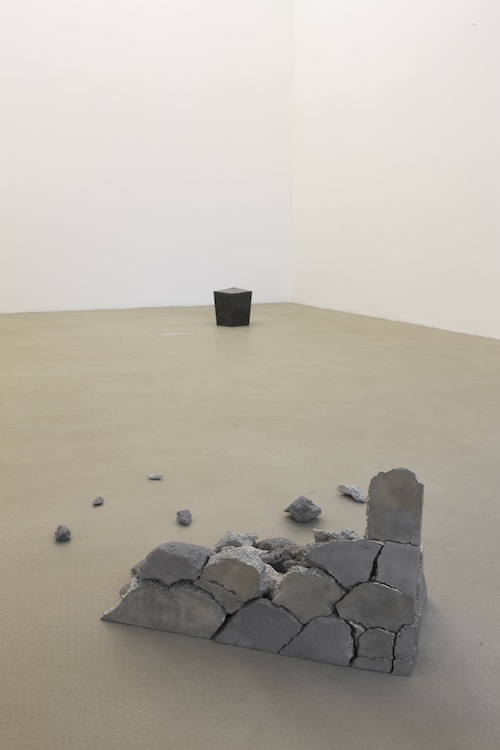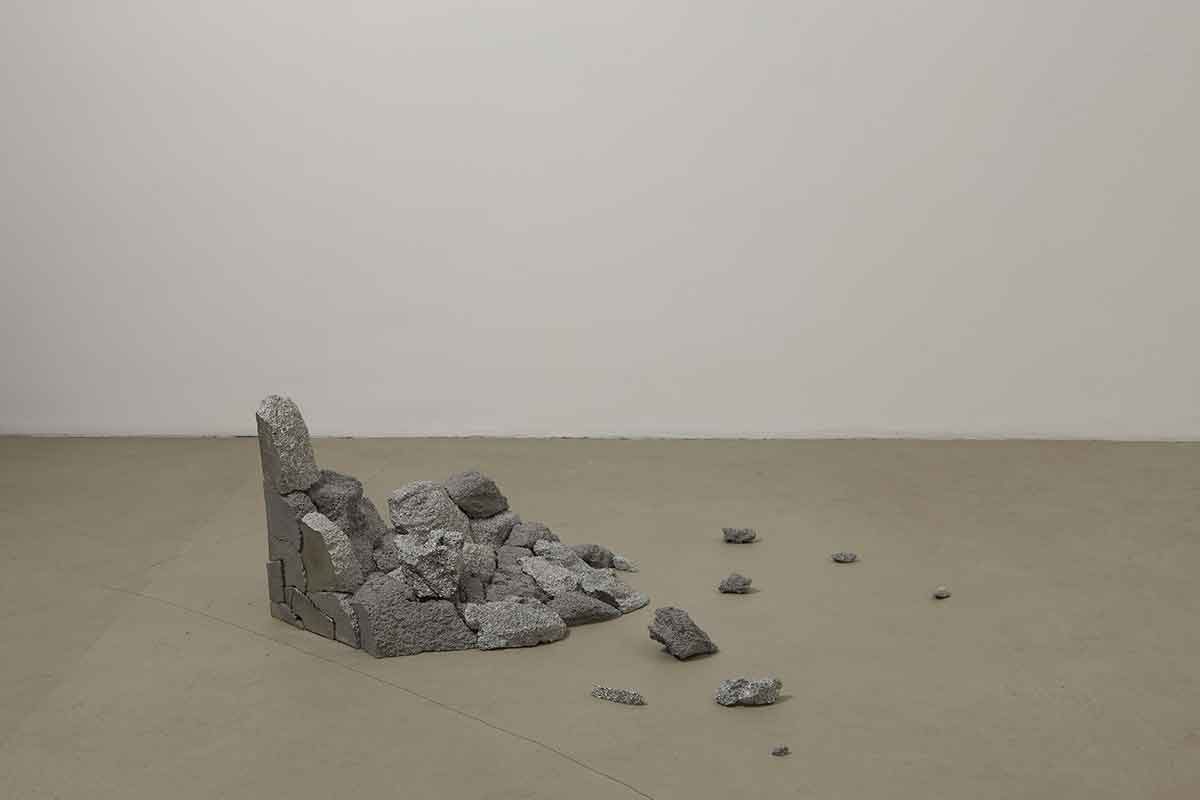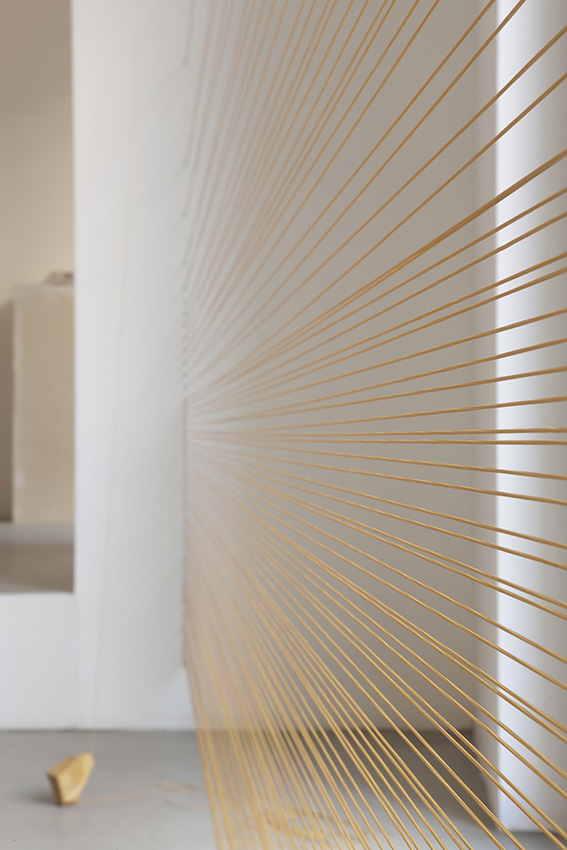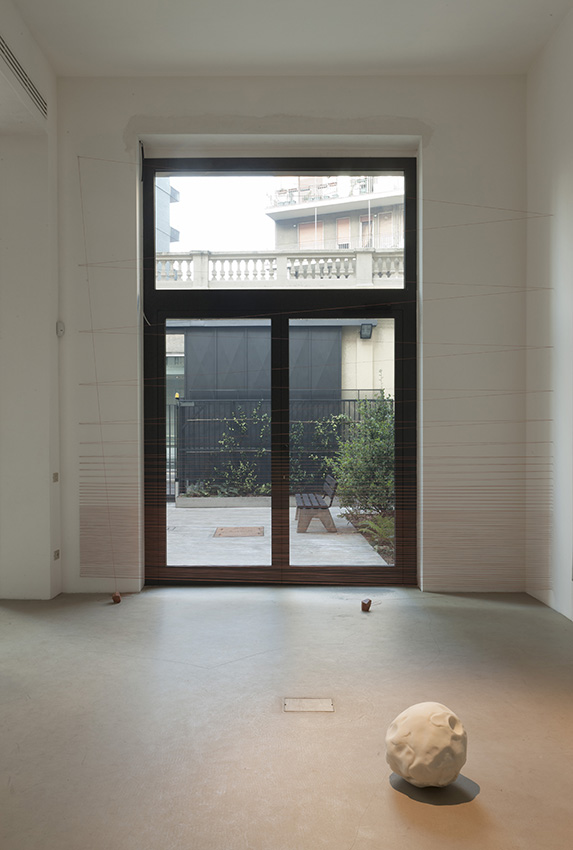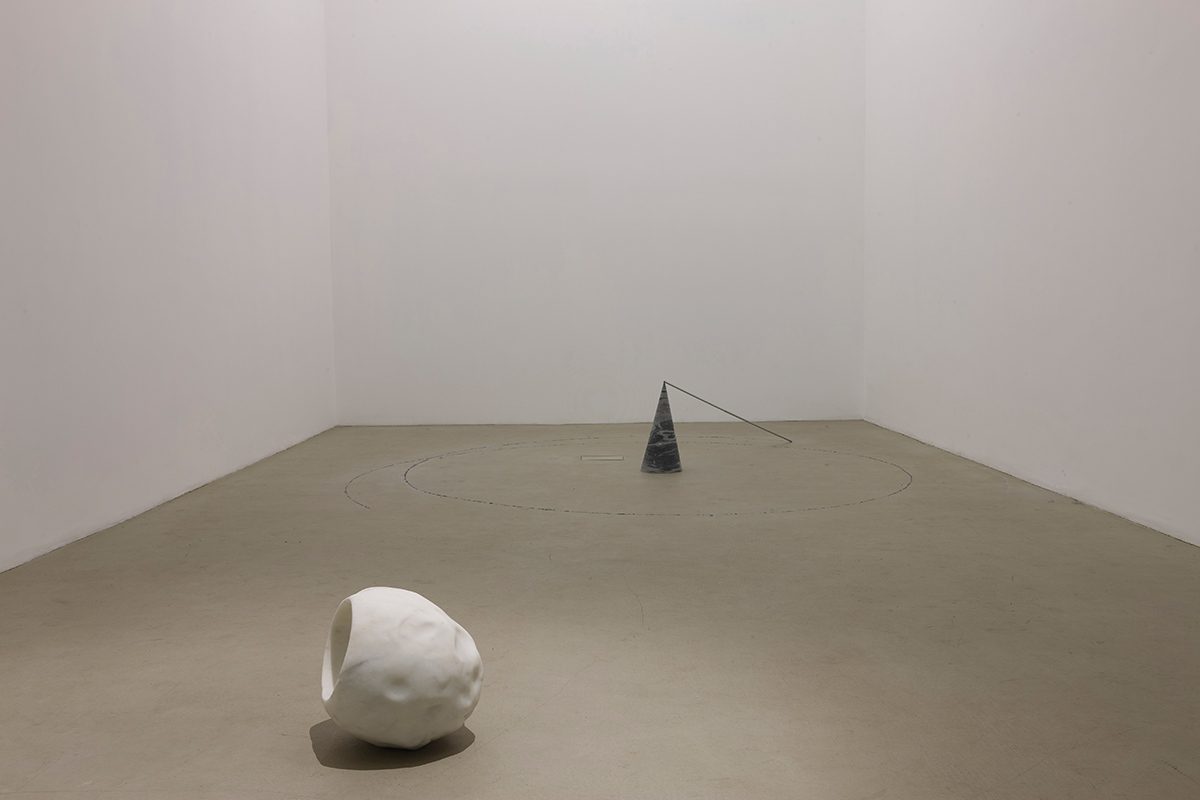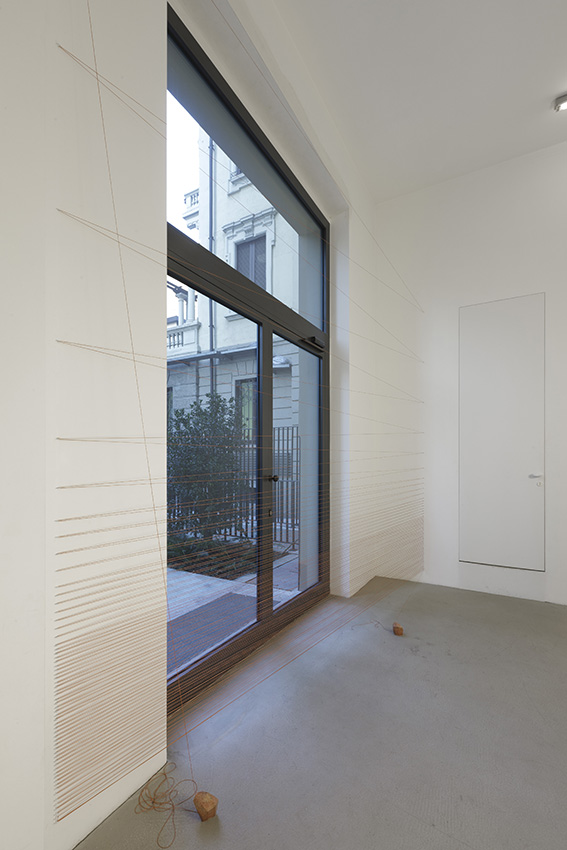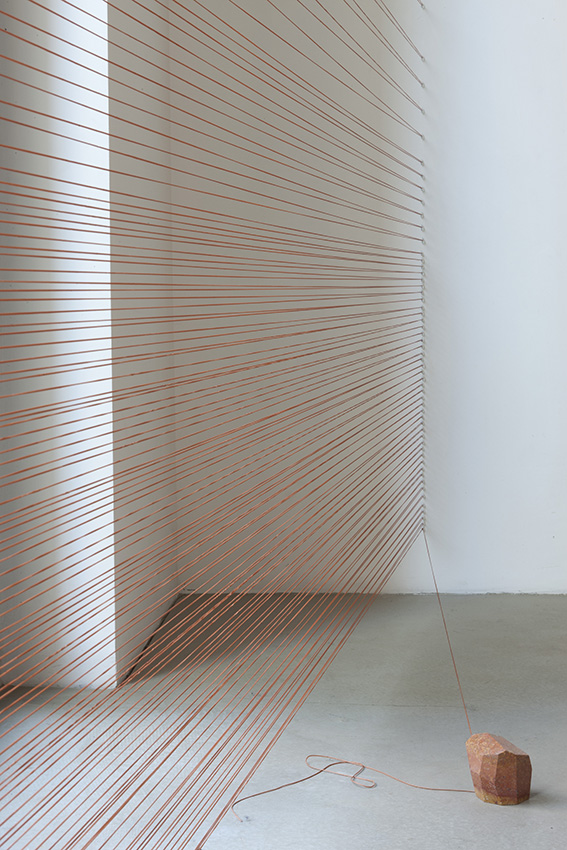
- This event has passed.
kaufmann repetto is glad to announce the new solo show by Gianni Caravaggio, “Weaver of Sunrises”.
The works that are part of the show are inspired by the connection between the artist’s practice and the culture of Japanese zen gardens, specifically the Daisen-in garden in Kyoto. The lines drawn in the garden represent the river of life, flowing circularly on a path that reproduces the endless sequence of days leading into emptiness.
In the same way as the zen garden is constantly regenerated, the works of Gianni Caravaggio result from a demiurgic act that functions both as the endpoint and the beginning of an endlessly repeated activation of creative processes. The show constitutes a setting of “seed-images”, capable of growing within the viewer.
Just like the rock-turtle of the Daisen-in garden swims against the tide of the river of life, Towards Eternity is a metaphor of the tragic – and at the same time poetic – attempt of defeating death. The work is constituted by a block of polystyrene, from which a segment is removed. The bits that have been removed are then cast in zinc or aluminium and recomposed at a distance from the original block. The assembly looks like a rocky landscape, evoking the organic body of the turtle and its shifting hues. The fragility of polystyrene is congealed in fragments of a durable material and thus brought toward eternity.
A similar encounter between the finite and the infinite is synthesized in Spreading one’s own Ashes: through a gesture that is both playful and metaphysical, the work illustrates the artist spreading his own ashes from the viewpoint of eternity. The aluminium arm, like the one of the artist, relates what would initially seem to be two different manifestations of the same material – the marble cone and the ashes – that transfigure one into the other and back again.
Two Moons with Amazement, an oval shape in white statuary marble, betrays its medium with a malleable aspect that bears the traces of the artist’s hand. Two concave shapes seem to be impressed in the sculpture. Depending on how the work is exposed to light, they reveal different lunar phases while at the same time outlining a face with its eyes and mouth wide open. The sculpture symbolizes the moon, and at the same time the amazement felt viewing the spectacle of the cosmos.
Sunrise and sunset open and close this scenery, obfuscating the entire space with two installations of threads that end in marble wedges synthesizing the artist’s hands. The two works, Weavers of Sunrises and Weavers of Sunsets, reproduce the always new – and always identical – flow of the lifecycle, since as the pre-Socratic philosopher Heraclitus said: “the Sun is new every day”.
Gianni Caravaggio, born in 1968 in Rocca S. Giovanni, Italy, lives and works in Milan and Stuttgart.
Selected solo exhibitions: Art Statements, francesca kaufmann, Art Basel (2009); Collezione Maramotti, Reggio Emilia, Italy, Già 39 anni su questo pianeta, La Pescheria, Galleria d’Arte Moderna, Pesaro, Italy (2008); Castello di Rivoli Prize, Castello di Rivoli, Rivoli, Italy (2005).
Selected group exhibitions: Arte essenziale, Collezione Maramotti, Reggio Emilia, Italy (2011); La scultura italiana del XXI secolo, Fondazione Pomodoro, Milan, Linguaggi e sperimentazioni. Giovani artisti in una collezione contemporanea, MART, Rovereto, Italy (2010); Energie sottili della materia, Academy of Painting, Bejing (2008); Scirocco, Künstlerhaus Palais Thurn und Taxis, Bregenz (2006).
kaufmann repetto è lieta di presentare la nuova mostra di Gianni Caravaggio intitolata ‘Tessitore di Albe’.
L’ispirazione sottesa ai lavori in mostra nasce da un intrinseco legame tra la propria concezione di creazione artistica e la cultura dei giardini zen giapponesi, in particolare quello di Daisen-in a Kyoto. Qui le linee nella ghiaia rappresentano il fiume della vita, che scorre circolarmente in un percorso che riproduce il susseguirsi dei giorni verso il vuoto.
Come il giardino zen, in cui ogni giorno viene rigenerato, i lavori di Gianni Caravaggio sono il risultato di un atto demiurgico, esito e punto di partenza di un’attivazione creativa che può ripetersi all’infinito. La mostra è uno scenario composto di ‘immagini-seme’, capaci di crescere in chi li osserva.
Come la tartaruga/roccia del giardino Daisen-in nuota contro lo scorrere del fiume della vita, così Verso l’eternità rappresenta metaforicamente il tentativo, tragico e poetico insieme, di sconfiggere la morte. Il lavoro è composto da un blocco di polistirolo al quale viene sottratta una parte pezzo dopo pezzo: i quali trasformati in zinco o in alluminio, vengono ricomposti a distanza. La modulazione di tale insieme, quasi un paesaggio roccioso, evoca il corpo organico e cangiante della tartaruga. La fragilità del polistirolo si solidifica in frammenti di materiali durevoli e così “portati verso l’eternità”.
Un simile incontro tra finito e infinito viene sintetizzato in Spargere le proprie ceneri: attraverso un gesto ludico e insieme metafisico, il lavoro illustra l’immagine dell’artista che sparge le proprie ceneri da un punto di vista dell’eternità. Il braccio di alluminio, come il braccio dell’artista, fa da tramite tra quelle che sembrano due diverse manifestazioni della stessa materia, il cono di marmo e la cenere, che trasfigurano l’una nell’altra, in un senso e nell’altro.
Due lune con stupore, una forma ovaloide in marmo bianco statuario, tradisce la sua materialità per l’aspetto malleabile, che porta le tracce della mano dell’artista. Su questo solido sembrano impresse due concavità che, a seconda della esposizione alla luce, svelano le diverse fasi lunari, e, allo stesso tempo, sembrano delineare un volto dagli occhi sgranati e la bocca spalancata. La scultura è la luna e insieme lo stupore per la visione dello spettacolo cosmico.
Alba e tramonto aprono e chiudono lo scenario, offuscando l’intero spazio attraverso due installazioni di fili che terminano in blocchetti di marmo, a sintetizzare le mani dell’artista. I due lavori, Tessitori di albe e Tessitori di tramonti, riproducono il sempre nuovo – e sempre uguale – flusso del ciclo vitale, poiché, come dichiarava il filosofo presocratico Eraclito, “Il sole è nuovo ogni giorno”.
Gianni Caravaggio, nato nel 1968 a Rocca S. Giovanni, Italy, vive e lavora a Milano e Stoccarda. Principali mostre personali: Art Statements, francesca kaufmann, Art Basel, Basilea (2009); Collezione Maramotti, Reggio Emilia, Già 39 anni su questo pianeta, La Pescheria, Galleria d’Arte Moderna, Pesaro (2008); Castello di Rivoli Prize, Castello di Rivoli, Rivoli (2005). Principali mostre collettive: Arte essenziale, Collezione Maramotti, Reggio Emilia (2011); La scultura italiana del XXI secolo, Fondazione Pomodoro, Milano, Linguaggi e sperimentazioni. Giovani artisti in una collezione contemporanea, MART, Rovereto (2010); Energie sottili della materia, Academy of Painting, Bejing (2008); Scirocco, Künstlerhaus Palais Thurn und Taxis, Bregenz (2006).

